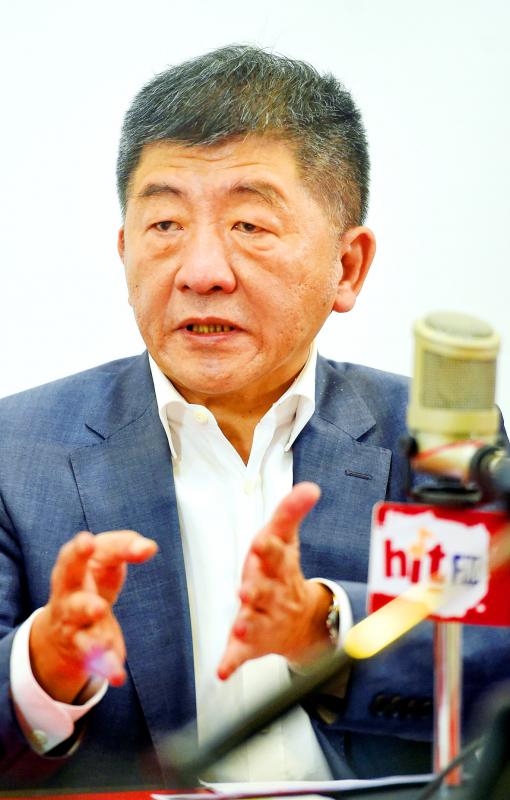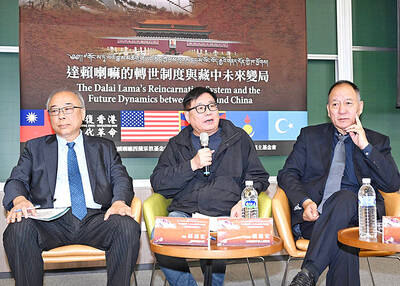Minister of Health and Welfare Chen Shih-chung (陳時中) yesterday said that allowing imports of US pork containing ractopamine is an exchange for a boost in Taiwan’s international status, but levels of the drug would be regulated based on scientific evidence, as people’s health is not negotiable.
Chen made the remarks in an interview with Hit FM radio host Clara Chou (周玉蔻), after President Tsai Ing-wen (蔡英文) on Friday announced that Taiwan would lift the bans on US pork containing ractopamine and beef from cattle over the age of 30 months.
The Executive Yuan said that the policy would take effect on Jan. 1 and is aimed at expanding international trade.

Photo: Liu Hsin-de, Taipei Times
However, the announcement has sparked debate over possible negative effects on the domestic pig farming industry and consumers’ health, and the Chinese Nationalist Party (KMT) strongly opposes it.
Asked about what Taiwan could get in exchange for easing restrictions on US pork and beef imports, Chen said: “International status for Taiwan.”
“A person needs status in society to negotiate with others, and status comes from respecting each other based on scientific evidence, so if we cannot even manage to do that, how can we establish Taiwan’s status?” he said. “Having international status could help us continue with many negotiations.”
Taiwan must review and modify its policies that are not aligned with international standards, otherwise it will deviate from international norms, which would create more problems, such as how to maintain state autonomy or develop economic growth, Chen said.
Regarding concerns over the health effects of eating pork containing ractopamine, he said that, unlike the COVID-19 pandemic, which has many uncertainties, the health risk from consuming US pork or beef can be controlled using scientific calculations.
The ban on importing beef from cattle over the age of 30 months was established because of bovine spongiform encephalopathy (BSE), also known as mad cow disease, Chen said.
However, as cattle feed — which was found to be the source — has been improved to prevent contamination, cattle traceability systems have been established and there are now inspections at slaughterhouses and marketplaces, the risk has been greatly reduced, he said.
A risk assessment report said that if a person consumes US bone-in beef every day, the risk of suffering variant Creutzfeldt-Jakob disease, which is caused by eating beef from cattle infected with BSE, is about one in 1 billion people, Chen said.
The Food and Drug Administration (FDA) has conducted health risk assessments on US pork and beef in the past two years, and as the maximum residue levels for ractopamine in pork is likely to be set at the level adopted by the Codex Alimentarius Commission, the FDA would review the standards again, and enhance labeling requirements, Chen said.
US pork containing ractopamine would be labeled, and those who label pork incorrectly would face a fine of between NT$40,000 and NT$4 million (US$1,355 and US$135,474), he said.
The amounts used for risk assessments usually exceed normal daily pork or beef consumption levels, so most people would not consume enough pork for ractopamine to affect their health, Chen said.
A person would have to eat at least 33 pork chops containing ractopamine every day to reach the amount considered to pose a risk to their health, he said, adding that a person might get cardiovascular disease from eating so much pork, and that only about 20 percent of the US pork contains ractopamine.
Chen said that the policy was not made politically, but according to scientific evidence.
In response to media queries after the interview, he said that people’s health is not negotiable, so the government would insist on ensuring food safety.

ALIGNED THINKING: Taiwan and Japan have a mutual interest in trade, culture and engineering, and can work together for stability, Cho Jung-tai said Taiwan and Japan are two like-minded countries willing to work together to form a “safety barrier” in the Indo-Pacific region, Premier Cho Jung-tai (卓榮泰) yesterday said at the opening ceremony of the 35th Taiwan-Japan Modern Engineering and Technology Symposium in Taipei. Taiwan and Japan are close geographically and closer emotionally, he added. Citing the overflowing of a barrier lake in the Mataian River (馬太鞍溪) in September, Cho said the submersible water level sensors given by Japan during the disaster helped Taiwan monitor the lake’s water levels more accurately. Japan also provided a lot of vaccines early in the outbreak of the COVID-19 pandemic,

Kaohsiung Mayor Chen Chi-mai (陳其邁) on Monday announced light shows and themed traffic lights to welcome fans of South Korean pop group Twice to the port city. The group is to play Kaohsiung on Saturday as part of its “This Is For” world tour. It would be the group’s first performance in Taiwan since its debut 10 years ago. The all-female group consists of five South Koreans, three Japanese and Tainan’s Chou Tzu-yu (周子瑜), the first Taiwan-born and raised member of a South Korean girl group. To promote the group’s arrival, the city has been holding a series of events, including a pop-up

TEMPORAL/SPIRITUAL: Beijing’s claim that the next Buddhist leader must come from China is a heavy-handed political maneuver that will fall flat-faced, experts said China’s requirement that the Dalai Lama’s reincarnation to be born in China and approved by Beijing has drawn criticism, with experts at a forum in Taipei yesterday saying that if Beijing were to put forth its own Dalai Lama, the person would not be recognized by the Tibetan Buddhist community. The experts made a remarks at the two-day forum hosted by the Tibet Religious Foundation of His Holiness the Dalai Lama titled: “The Snow Land Forum: Finding Common Ground on Tibet.” China says it has the right to determine the Dalai Lama’s reincarnation, as it claims sovereignty over Tibet since ancient times,

Temperatures in some parts of Taiwan are expected to fall sharply to lows of 15°C later this week as seasonal northeasterly winds strengthen, the Central Weather Administration (CWA) said today. It is to be the strongest cold wave to affect northern Taiwan this autumn, while Chiayi County in the southwest and some parts of central Taiwan are likely to also see lower temperatures due to radiational cooling, which occurs under conditions of clear skies, light winds and dry weather, the CWA said. Across Taiwan, temperatures are to fall gradually this week, dropping to 15°C to 16°C in the early hours of Wednesday